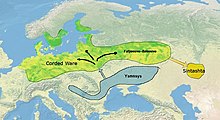The Middle Dnieper culture or the Middle Dnipro culture[1] (Ukrainian: Середньодніпро́вська культу́ра, romanized: Seredn'odniprovs'ka kul'tura; Belarusian: Сярэднедняпроўская культура, romanized: Siaredniedniaproûskaja kuĺtura) is a formative early expression of the Corded Ware culture,[2] ca. 2800–1800 BC,[3] of northern Ukraine and Belarus.


Distribution
editAs the name indicates, it was centered on the middle reach of the Dnieper River and is contemporaneous with the latter phase and then a successor to the Indo-European Yamnaya culture, as well as to the latter phase of the Cucuteni–Trypillia culture.
Geographically, the Middle Dnieper culture is directly behind the area occupied by the Globular Amphora culture (south and east), and while commencing a little later and lasting a little longer, it is otherwise contemporaneous with it.
The Fatyanovo–Balanovo culture is, in turn, considered an eastern extension of the Middle Dnieper culture.
Characteristics
editMore than 200 sites are attested to, mostly as barrow inhumations under tumuli; some of these burials are secondary depositions into Yamnaya-era kurgans. Grave goods included pottery and stone battle-axes. There is some evidence of cremation in the northerly area. Settlements seem difficult to define; the economy was much like that of the Yamna and Corded Ware cultures, semi-to-fully-nomadic pastoralism.[4]
Ethnicity
editWithin the context of the Kurgan hypothesis of Marija Gimbutas, this culture is a major center for migrations (or invasions, if one prefers) from the Yamnaya culture and its immediate successors into Northern and Central Europe.
It has been argued that the area where the Middle Dnieper culture is situated would have provided a better migration route for steppe tribes along the Pripyat tributary of the Dnieper and perhaps provided the cultural bridge between Yamnaya and Corded Ware cultures. This area has also been a classic invasion route, as seen historically with the armies of the Mongol Golden Horde (moving east to west from the steppes) and Napoleon Bonaparte (moving west to east from Europe).[5]
On the other hand, the Middle-Dnieper culture has been viewed as a contact zone between Yamnaya steppe tribes and occupants of the forest steppe zone, possibly signaling communications between pre-Indo-Iranian speakers and pre-Balto-Slavs as interpreted by an exchange of material goods evident in the archaeological record sans migration.[6]
See also
editReferences
edit- ^ Klochko, Viktor (2024). "The Most Ancient Metal Spearheads in Eastern Europe (on Reconstructing the Indo-European Weaponry Complex)". Annals of Archaeology. 6 (1): 13–29. doi:10.22259/2639-3662.0601002. ISSN 2639-3662.
- ^ Nordqvist and Heyd, The Forgotten Child of the Wider Corded Ware Family: Russian Fatyanovo Culture in Context, Proceedings of the Prehistoric Society, online 12 November 2020, DOI: https://doi.org/10.1017/ppr.2020.9
- ^ Anthony, David W. (2007). The Horse, the Wheel, and Language: How Bronze-Age Riders from the Eurasian Steppes Shaped the Modern World. Princeton University Press. ISBN 978-0-691-14818-2.
- ^ J. P. Mallory, "Middle Dnieper Culture", Encyclopedia of Indo-European culture, Fitzroy Dearborn, 1997.
- ^ Rifkin, M. 2007. A Spatial Analysis of Neolithic Cultures throughout Eastern, Central, and Northern Europe in Relation to Proto-Germanic. Journal of Indo-European Studies. 35 (1 & 2): 53–81
- ^ Telegin, D. 2005. The Yamnaya Culture and the Indo-European Homeland Problem. Journal of Indo-European Studies. 33 (3 & 4): 339–358